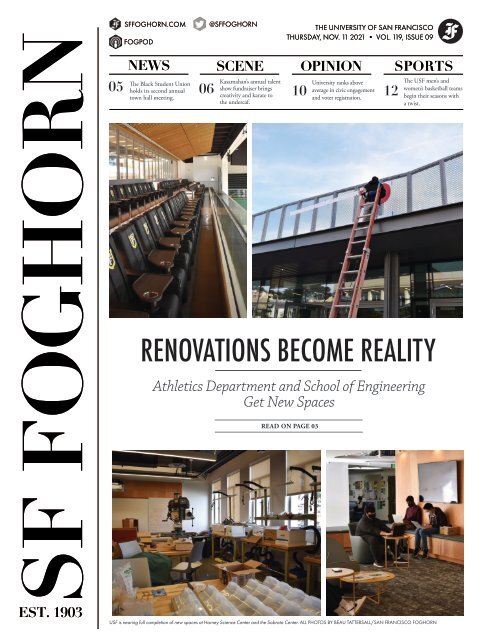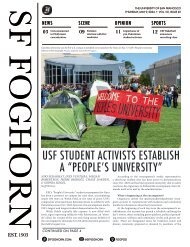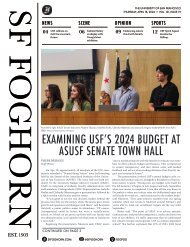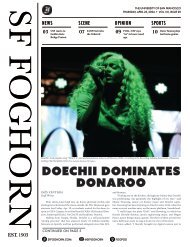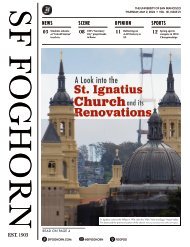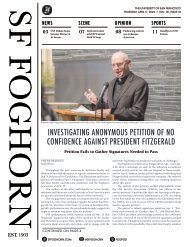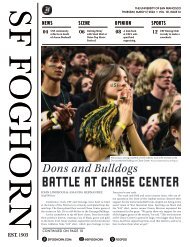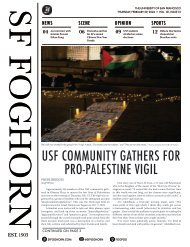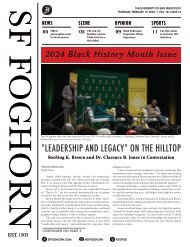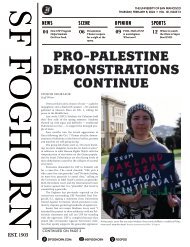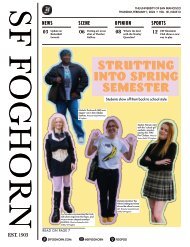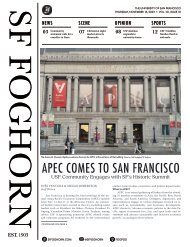VOL 119, Issue 9—Nov. 11, 2021
- No tags were found...
Create successful ePaper yourself
Turn your PDF publications into a flip-book with our unique Google optimized e-Paper software.
SF FOGHORN<br />
EST. 1903<br />
05<br />
SFFOGHORN.COM<br />
FOGPOD<br />
NEWS<br />
The Black Student Union<br />
holds its second annual<br />
town hall meeting.<br />
@SFFOGHORN<br />
THE UNIVERSITY OF SAN FRANCISCO<br />
THURSDAY, NOV. <strong>11</strong> <strong>2021</strong> • <strong>VOL</strong>. <strong><strong>11</strong>9</strong>, ISSUE 09<br />
SCENE OPINION SPORTS<br />
Kasamahan’s annual talent<br />
University ranks above<br />
06<br />
show fundraiser brings<br />
10 average in civic engagement 12<br />
creativity and karate to<br />
the undercaf.<br />
and voter registration.<br />
The USF men’s and<br />
women’s basketball teams<br />
begin their seasons with<br />
a twist.<br />
RENOVATIONS BECOME REALITY<br />
Athletics Department and School of Engineering<br />
Get New Spaces<br />
READ ON PAGE 03<br />
USF is nearing full completion of new spaces at Harney Science Center and the Sobrato Center. ALL PHOTOS BY BEAU TATTERSALL/SAN FRANCISCO FOGHORN
02<br />
THURSDAY<br />
NOV. <strong>11</strong><br />
<strong>2021</strong><br />
STAFF<br />
SUBMISSION POLICY<br />
The San Francisco Foghorn is the<br />
official student newspaper of the<br />
University of San Francisco and is<br />
sponsored by the Associated Students<br />
of the University of San Francisco<br />
(ASUSF).<br />
The thoughts and opinions expressed<br />
herein are those of the individual writers<br />
and do not necessarily reflect those<br />
of the Foghorn staff, the administration,<br />
the faculty, staff or the students<br />
of the University of San Francisco.<br />
Contents of each issue are the sole<br />
responsibilities of the editors.<br />
An All-American<br />
Publication<br />
ad maiorem dei<br />
gloriam<br />
The San Francisco Foghorn is free of<br />
charge, one copy per reader. To purchase<br />
additional copies for $1, please<br />
visit our office.<br />
Advertising matter printed herein is<br />
solely for informational purposes.<br />
Such printing is not to be construed<br />
as written or implied sponsorship<br />
or endorsement of such commercial<br />
enterprises or ventures by the San<br />
Francisco Foghorn.<br />
©MMIV-MMV, San Francisco Foghorn.<br />
All rights reserved. No material<br />
SAN FRANCISCO<br />
FOGHORN<br />
Freedom and Fairness<br />
415.422.5444<br />
sffoghorn.com<br />
Editor in Chief<br />
LUCIA VERZOLA<br />
editorinchief@sffoghorn.com<br />
News Editor<br />
MIGUEL ARCAYENA<br />
news@sffoghorn.com<br />
Opinion Editor<br />
ZOE BINDER<br />
opinion@sffoghorn.com<br />
Scene Editor<br />
CALLIE FAUSEY<br />
scene@sffoghorn.com<br />
Sports Editor<br />
MAGGIE ALDRICH<br />
sports@sffoghorn.com<br />
Photography Editor<br />
BEAU TATTERSALL<br />
photo@sffoghorn.com<br />
General Reporter<br />
ANNIKA DAHLBERG<br />
reporter1@sffoghorn.com<br />
General Reporter<br />
MEGAN ROBERTSON<br />
reporter2@sffoghorn.com<br />
Managing Editor<br />
JAMES SALAZAR<br />
managing@sffoghorn.com<br />
Copy Editor<br />
NORA WARD<br />
copy@sffoghorn.com<br />
Layout Editor<br />
DOMINIQUE CADENAS CALVO<br />
layout@sffoghorn.com<br />
Layout Editor<br />
LOUISE DE OLIVEIRA<br />
layout2@sffoghorn.com<br />
Social Media Manager<br />
SAMANTHA BERLANGA<br />
socialmedia@sffoghorn.com<br />
Online Editor<br />
CLAIRE JACOBS<br />
online@sffoghorn.com<br />
Advisor<br />
TERESA MOORE<br />
2130 FULTON STREET, UC #417<br />
SAN FRANCISCO, CA 94<strong>11</strong>7<br />
printed herein may be reproduced<br />
without prior permission of the Editor<br />
in Chief.<br />
Columns for the Opinion section<br />
and Letters to the Editor are gladly<br />
accepted from students, faculty, staff<br />
and alumni.<br />
All materials must be signed and<br />
include your printed name, university<br />
status (class standing or title), address,<br />
and telephone number for verification.<br />
Anonymous submissions are not<br />
published.<br />
We reserve the right to edit materials<br />
submitted. All submissions become the<br />
property of the San Francisco Foghorn.<br />
Columns of not more than 900 words<br />
should be submitted by 5 p.m. on the<br />
Wednesday before publication.<br />
Letters of 500 words or less should<br />
be submitted by 5 p.m. on the Friday<br />
before publication.<br />
Staff editorials are written by the<br />
Foghorn editorial staff and represent a<br />
group consensus.<br />
The San Francisco Foghorn Opinion<br />
page is a forum for the free, fair and<br />
civil exchange of ideas. Contributors’<br />
opinions are not meant to reflect<br />
the views of the Foghorn staff or the<br />
University of San Francisco.<br />
STAFF EDITORIAL<br />
COP26 SERVES AS A REMINDER OF<br />
OUR ENVIRONMENTAL RESPONSIBILITY<br />
Following a year of historic weather events<br />
across the globe, the <strong>2021</strong> United Nations Climate<br />
Conference, or COP26, began on Oct. 31,<br />
bringing together world leaders, environmental<br />
advocates, and key players in the fossil fuel industry<br />
to negotiate the planet’s future. The event,<br />
which is still in progress and taking place in<br />
Glasgow, Scotland, ends on Nov. 12. Our staff<br />
reflected on the ongoing results of the conference<br />
and on the role we all play in working to mitigate<br />
the effects of climate change.<br />
Nations attending this year’s climate conference<br />
are already making promises to protect vital<br />
aspects of the environment, such as forests. So far,<br />
over 100 world leaders have vowed to end deforestation<br />
and begin to reverse its adverse effects<br />
by 2030. Efforts will include directing funding<br />
toward developing countries to restore damaged<br />
land, tackling wildfires, and supporting indigenous<br />
communities. Some countries also committed<br />
to removing deforestation from the global<br />
trade of food and other products like palm oil<br />
and cocoa. This marks the first official deal made<br />
during the conference, with countries like Brazil,<br />
where stretches of the Amazon rainforest have<br />
been clear-cut, signing on to cooperate.<br />
Other results include a pledge by 45 nations<br />
to shift to sustainable methods of conducting<br />
agriculture and a promise made by 95 companies,<br />
including the World Bank, to become more<br />
“Nature Positive” by 2030. The “Nature Positive”<br />
sentiment has major companies agreeing to work<br />
on the affordability and attractiveness of sustainability.<br />
While these promises sound hopeful, we<br />
want our leaders’ promises to live beyond the<br />
summit. Without the cooperation of major industries<br />
and fossil fuel companies, which are<br />
responsible for most of the earth’s global carbon<br />
emissions, governments can make little progress<br />
in fighting to keep a habitable planet.<br />
The pledge by 95 companies to become<br />
“Nature Positive” does not match the urgency of<br />
the environmental crisis in the slightest. Having<br />
companies agree to begin to make sustainability<br />
attractive in the business world seems like a baby<br />
step in place of what should be a massive leap.<br />
Equally as alarming is the fact that 503 attendees<br />
of the conference have been identified as fossil<br />
fuel lobbyists. We assert that conversations about<br />
ending fossil fuel consumption cannot reach fruition<br />
with fossil fuel lobbyists present as some participants<br />
might operate with ulterior motives that<br />
benefit their agendas.<br />
Though we cannot directly influence the<br />
outcomes of this global event, COP26 brings up<br />
urgent conversations around climate change that<br />
need to be had on a local level, starting with our<br />
University.<br />
Since the start of this school year, the University<br />
has vocalized its commitment to combating<br />
climate change in various ways, mainly<br />
through widespread discussion. For example,<br />
this semester, the Honors College is focusing on<br />
the theme of “Voices for Environmental Justice,”<br />
hosting interdisciplinary student-faculty panels<br />
that are open to all students. Thacher Gallery’s<br />
current exhibit, “All that you touch: art and ecology”<br />
also centralizes environmental themes.<br />
Other tangible changes include Bon Appetit’s<br />
operations as the company now offers sustainably<br />
farmed meats and produce in all University<br />
cafes. Options like “mindful meats,” organic,<br />
non-GMO, project verified, pasture-raised beef,<br />
are being offered from Marin Sun Farms. The<br />
menus also have vegan and vegetarian alternatives<br />
to meat-heavy meals, and these options allow students<br />
to make conscious choices about their diet<br />
and their connection to the environment.<br />
Additionally, the University has promoted<br />
campus resources like the USF community garden,<br />
where students, especially those with food<br />
insecurity, can be provided fresh food for free.<br />
This space promotes sustainable agriculture at<br />
USF and gives students a way to directly interact<br />
with food at its source.<br />
Compostable boxes and utensils used in<br />
University cafes are also a significant step towards<br />
sustainability since it is estimated only six percent<br />
of university campuses compost. However,<br />
despite the signage on trash bins all over campus,<br />
we feel that students remain largely uninterested<br />
in how to properly separate their trash, with recycling<br />
rooms in residence halls often overflowing<br />
with uncrushed cardboard boxes, food scraps<br />
in the recycling bins, and plastic mixed in with<br />
compostables.<br />
We believe that the University sufficiently<br />
promotes a sustainable and environmentally<br />
conscious mentality. However, we find that more<br />
work can be done to highlight the efforts and resources<br />
put forth by the Office of Sustainability.<br />
Events like trivia nights, DIY interactive activities,<br />
and documentary showings are held weekly<br />
but the lack of advertising hurts attendance. The<br />
University should loosen its physical poster restriction<br />
and advertise these events in newsletters<br />
to create greater awareness and increase student<br />
attendance.<br />
That being said, while appreciating the work<br />
the University has done to promote sustainability,<br />
students also need to avoid complacency and<br />
embrace the opportunities provided to us to live<br />
a sustainable lifestyle while on campus. For instance,<br />
making the effort to eat in the cafeteria<br />
and use a reusable plate rather than paying for a<br />
to-go box is an accessible step that is right at our<br />
fingertips, yet many ignore it.<br />
Being proud of our University for its sustainability<br />
efforts while also demanding more<br />
requires self-accountability. With increased participation<br />
in sustainability efforts on campus, we<br />
can confront the enormous challenge of climate<br />
change knowing we are contributing to effective<br />
solutions in the ways we can.<br />
For more information on USF’s sustainability<br />
efforts and up to date events offered for students, follow<br />
@sustainabilityusfca on Instagram.<br />
PHOTO COURTESY OF WIKIMEDIA COMMONS
RENOVATIONS BECOME REALITY • Front Page<br />
ANNIKA DAHLBERG<br />
Staff Writer<br />
New club level seating inside the War Memorial Gym at the Sobrato Center opened to guests on Nov.<br />
9, while a hall of fame museum dedicated to social justice remains under construction. PHOTO BY BEAU<br />
TATTERSALL/SAN FRANCISCO FOGHORN<br />
03<br />
After years of construction halted by the pandemic, the University<br />
has new spaces for students to visit as two donor-sponsored<br />
projects are moving toward completion.<br />
Opening its doors just in time for the college basketball season,<br />
the Sobrato Center is a new space on the West side of the<br />
War Memorial Gym that faces the University Center and will<br />
function as the gym's new main entrance for athletics and other<br />
events. During home games for women’s volleyball and men’s<br />
and women’s basketball, the space functions as a VIP area for<br />
guests. When not in use during game days, the space can be used<br />
by students and staff as a work space, lecture room, study space,<br />
and more. The space features TVs, projectors, and speakers that<br />
can be used by visitors. The design includes polished concrete<br />
and open painted ceilings as a cost-saving measure and features<br />
counters made from the recycled wood of the gym’s old bleachers<br />
that were removed during construction. This space leads into<br />
the new premium seating area for games and features cushioned<br />
reclining chairs. Soon, the entrance to the space will feature an<br />
interactive basketball-themed water feature. The project was<br />
sponsored by the Sobrato family, who donated a historic $15<br />
million gift in 2016 to launch the renovation project.<br />
Athletic Director Joan McDermott sees the renovation as<br />
a way to integrate the athletics department with the USF community,<br />
utilizing a shared space. “We really wanted to kind of<br />
be the center of campus in many ways. That's why we have that<br />
new entrance. I think it really draws students to the building,”<br />
McDermott said. “We don't want Athletics just to be this little<br />
group of students over here in the corner. It's important that we<br />
are involved with the University community as a whole. This is<br />
our way of inviting the campus community into the building to<br />
utilize it.”<br />
War Memorial's old entrance on Golden Gate Avenue is<br />
being turned into a Social Justice Hall of Fame that will tie moments<br />
in the University athletics’ history with the school’s social<br />
justice initiatives. “We'll start the social justice museum, and<br />
we're going to thread that through the building. We're going<br />
to have different places in the building where the story is told,”<br />
McDermott said. “Whether it's the 1951 Dons football team, or<br />
the ‘55 and ‘56 men's basketball teams, we are trying to tie it in<br />
over the years.”<br />
Elsewhere on campus, the Innovation Hive in Harney Science<br />
Center is now open, which provides two spaces for students<br />
to work. One space, situated at the building’s main entrance, is<br />
open for all and provides seating and whiteboards students can<br />
use for studying. The second space is located behind the public<br />
area. This space is for the new school of engineering students<br />
to design and build model prototypes and projects. The section<br />
features machinery including a laser cutter, 3D printers, drill<br />
presses, industrial printers, and lockers for students to store their<br />
designs. The space was a gift to the School of Engineering in<br />
celebration of the new engineering program.<br />
Director of Engineering Laboratories Sean Olson has played<br />
a vital role in getting the space ready for students. “My excitement<br />
for the Hive gets all wrapped up in my excitement for having<br />
students back on campus. My role has been to consolidate<br />
two main goals and share these needs with facilities who have<br />
been coordinating with the architects and construction for the<br />
design and build of the new lab,” Olson said.<br />
“My first role has been working with Dr. Julia Thompson,<br />
the faculty director of the hive, to look at how and with what<br />
equipment project classes will be taught in the Hive. The second<br />
is planning out how the Hive will be used by engineering and the<br />
rest of campus outside of the engineering project classes.”<br />
The new workspace, which used to be office space, is projected<br />
to be ready for classes in January 2022.<br />
NEWS<br />
James Salazar contributed to the reporting of this article.<br />
The space will be exclusively used by the new School of Engineering. PHOTO BY BEAU TATTERSALL/SAN<br />
FRANCISCO FOGHORN
04<br />
THURSDAY<br />
NOV. <strong>11</strong><br />
<strong>2021</strong><br />
TITLE IX OFFICE POLICIES STRIVE<br />
‘TO GO BEYOND FOR EVERYONE’<br />
NEWS<br />
MEGAN ROBERTSON<br />
Staff Writer<br />
Following allegations of a prevalent culture of sexual violence within<br />
USF’s men’s soccer, the University’s Title IX office and its practices have become<br />
a frequent topic of conversation regarding how the school handles instances<br />
of sexual abuse.<br />
Since spring 2020, the office has implemented changes in policy and programs,<br />
including more prevention education for new students and athletic<br />
teams, improved student task forces, and increased community involvement.<br />
Title IX itself is a federal civil rights law that was passed in 1972, ensuring<br />
protections against sex-based discrimination in education programs and<br />
activities that receive federal financial assistance. According to their mission<br />
statement, USF’s Title IX office deals with all reports of sexual misconduct<br />
experienced by the campus community.<br />
In April, the office hired Katrina “Trina” Garry as the new deputy Title<br />
IX coordinator. Jess Varga, the Title IX Coordinator, controls most of the<br />
administrative tasks in the office, such as maintaining data and coordinating<br />
logistics of formal grievance processes while Garry was hired to be “out in the<br />
community, helping train our student leaders,” she said.<br />
According to Varga, Garry’s hiring by the selection committee “was resounding<br />
and unanimous.”<br />
Garry previously worked at Yale University for three years, where she<br />
headed their consent programs. She also worked in Yale’s Office of Gender<br />
and Campus Culture and the Alcohol and Other Drugs Harm Reduction Initiative.<br />
“From my experience working at Yale, supporting students and thinking<br />
about survivorship, I definitely am excited to be supporting survivors here and<br />
creating more opportunities for students to get involved,” Garry said.<br />
Garry is the point person for the office’s new Resources, Education, Prevention<br />
and Support (REPS) committee. This program, formerly a general<br />
Title IX committee, was created with aid from ASUSF Senate with a goal of<br />
eradicating sexual violence on the Hilltop. The committee of <strong>11</strong> students hosts<br />
events and workshops with various community groups to increase prevention<br />
education. With the REPS committee, “we’re trying to close the gap on student<br />
activism and opportunities for engagement,” Garry said.<br />
Garry’s hiring was directly related to the sexual abuse allegations and<br />
subsequent investigation surrounding the USF men’s soccer team. She was<br />
aware of the issue and excited to bring her experience as a former collegiate<br />
level athlete to the table as the point person between the athletics department<br />
and the Title IX office.<br />
Garry’s prevention plan does not stop with sports, however. “I am really<br />
excited to help create formative changes to our preventative education strategy,<br />
across campus, not just with student athletes,” she said. “That started this<br />
year with our orientation, the change in its modality.”<br />
This past August, students attending first and second-year orientations<br />
worked in small groups, facilitated by student orientation leaders, to discuss<br />
reactions to real scenarios of sexual misconduct. This was another change from<br />
the Title IX office, as they moved away from the large, lecture-style discussions<br />
of previous years.<br />
“I thought going through the scenarios was effective,” said Celeste Baird,<br />
a sophomore international studies major. “Having something where students<br />
could think about what they should do, instead of just being talked at.”<br />
Garry also led a first-year discussion of “So, You Want to Talk About<br />
Race” by Ijeoma Oluo, something which she said she was thrilled to do, with<br />
anti-racism work being important to her.<br />
“You can’t do sexual violence prevention and response work witthout<br />
considering intersectionality,” she said. “BIPOC and LGBTQ+ students are<br />
dispraportionatley affected by sexual violence.”<br />
As someone who “cherishes student activism,” Garry had the opportunity<br />
to work with Varga, Vice Provost Julie Orio, and Dean of Students Shannon<br />
Gary to coordinate the University’s response to demands from It’s On USFCA<br />
and the University’s handling of sexual abuse on campus.<br />
The responses combined “things that we’re already doing, and where we<br />
want to see ourselves go in the future, opening the door to allow for continual<br />
feedback and engagement,” Varga said.<br />
Varga said that all the replies were believed to be tangible and reachable.<br />
“I didn’t want any of those responses to be false promises,” she said. “We don’t<br />
want to just meet benchmarks, we want to go beyond for everyone.”<br />
Community involvement in sexual violence prevention is of great importance<br />
to both Varga and Garry. “While Jess and I are working at it from an<br />
institutional level, there are small ways that we can all get involved in this kind<br />
of work,” Garry said.<br />
“We care about our community,” Varga said. “That’s always centered at<br />
the forefront of what we’re doing.”<br />
The Title IX office can be reached titleIX@usfca.edu and the REPS committee<br />
can be contacted @USFCA_REPS on Instagram.<br />
Megan Robertson is a sophomore media studies and performing arts & social<br />
justice double major. She can be reached at mrrobertson2@dons.usfca.edu or on<br />
Instagram @megrrobertson<br />
USF’s Title IX Coordinator Jess Varga. PHOTO COURTESY OF OFFICE OF MARKETING &<br />
COMMUNICATIONS<br />
Title IX Deputy Coordinator Trina Garry. PHOTO COURTESY OF OFFICE OF MARKETING &<br />
COMMUNICATIONS
BLACK STUDENT UNION HOLDS SECOND ANNUAL<br />
TOWN HALL MEETING<br />
TALEAH JOHNSON<br />
Contributing Writer<br />
05<br />
The Black Student Union (BSU) held a town<br />
hall to amplify members’ opinions and concerns<br />
about various aspects and departments that affect<br />
the lives of USF students. Held on Nov. 3, D’Vine<br />
Riley, president of the BSU, called its second annual<br />
meeting a “brave space where we can challenge each<br />
other in a loving way.”<br />
Riley began the event with a statement of intent<br />
and poetry reading of Valerie Kaur’s “See No<br />
Stranger.” She then called forward Black representatives<br />
from various departments. These individuals<br />
introduced themselves and their departments to<br />
new members of the community and gave updates<br />
on existing and future developments that may directly<br />
affect students at USF.<br />
Secretary of BSU Amida Nigena and Director<br />
of Publicity De’Jena McClean led a community discussion<br />
on residential life. The two most repeated<br />
issues were Black students feeling uncomfortable<br />
in USF dorms and a lack of transparency regarding<br />
reporting Residential Advisors (RAs) for microaggressions.<br />
On the topic of discomfort and microaggressions<br />
in the dorms, one student in a living learning<br />
community commented on his feelings regarding<br />
leaving the safety of his community hall to attend<br />
classes on a daily basis. “As soon as I leave, it’s all<br />
eyes on me again,” he said. Other students outside<br />
of living learning communities repeated how isolated<br />
they felt on their own floors and the many small<br />
ways they are reminded of their differences from<br />
their peers. From overhearing alienating conservations<br />
about Black culture from non-Black students<br />
to witnessing inappropriate posters on personal residence<br />
dorm doors, students shared the multiple<br />
ways they have struggled in having USF feel like<br />
home.<br />
Students also shared what they believed to be<br />
a lack of transparency regarding reports to SHaRE<br />
about RAs and other members of USF’s residential<br />
community. Students were not only frustrated that<br />
they were not communicated with about the end<br />
result of their reports but that they weren’t involved<br />
in the restorative process. One student argued that<br />
“we shouldn’t be making complaints one day and<br />
then not seeing change a month later.”<br />
Although the majority of students agreed with<br />
the sentiment of more transparency, Assistant Dean<br />
of Students and Director of Community Living Dr.<br />
Aja Holmes disclosed that the end result of a report<br />
against a student becomes a part of that student’s file<br />
and to release any information from that file would<br />
result in a breach of the Family Educational Rights<br />
and Privacy Act (FERPA).<br />
Holmes and the attendees agreed to a possible<br />
confirmation email solution where those who filed<br />
the complaints would receive some sort of notification<br />
that SHaRE looked into their complaint and<br />
took the appropriate actions to resolve it.<br />
Black RAs also shared their apprehensions toward<br />
calling Public Safety on their residents. They<br />
want to restructure their relationships with residents<br />
to correct potential power imbalances. One RA in<br />
attendance called for implementing an unarmed<br />
taskforce to handle nonviolent transgressions like<br />
on campus drug use and mental health emergencies<br />
arguing that “guns aren’t necessary for a community<br />
like ours.” Holmes reminded the RA that they can<br />
Among the administrators that spoke at the town hall is the Assistant Dean of Students and Director of Community Living, Dr. Aja<br />
Holmes. PHOTO BY BAILEY STEADMAN/SAN FRANCISCO FOGHORN<br />
specify that they need the assistance of unarmed officers<br />
but did offer to consider the RA’s proposal.<br />
Program Assistant and Secretary of the Progressive<br />
Policing Committee Advisory Board (PPCAB)<br />
Kahanu Salavea and Black Achievement Success<br />
and Engagement (BASE) seat Shiara Coleman introduced<br />
their goal to have PPCAB act as a liaison<br />
for students and staff to talk to Public Safety. Salavea<br />
and Coleman displayed the Public Safety Community<br />
Comment Form where members of the USF<br />
community can submit comments or concerns<br />
about Public Safety and its officers.<br />
Public Safety Dispatch Supervisor April<br />
Al-Shamma disclosed the work Public Safety officers<br />
have been doing to combat possible racial bias<br />
in their duties. The officers have been undergoing<br />
training that tackles racism, racial justice, and policing<br />
in higher education institutions. Additionally,<br />
officers and the USF community have been participating<br />
in listening circles where community members<br />
and officers alike can discuss their own relationships<br />
to and opinions about policing.<br />
BASE Administrative Intern Monzerrad Fierro<br />
reminded the town hall attendees that BASE aims<br />
to “holistically” help Black students by “aiding and<br />
empower[ing]” them. Aside from a living learning<br />
community, BASE also has resources like the Black<br />
Scholars Scholarship that provides free tuition to a<br />
select number of incoming freshmen, and a Black<br />
Resource Center, which hosts a variety of programming<br />
for undergraduate and graduate students. As<br />
Fierro summarized, “BASE is your base, your home,<br />
your core.”<br />
Holmes also spoke about her goals of supporting<br />
all USF students, regardless of their on-campus<br />
or off-campus residency through “edutainment”, a<br />
mixture of entertaining but educational programming.<br />
Aside from aiding students through the transition<br />
from residency halls to apartment life,there is<br />
also a push for expanding the USF food pantry and<br />
a search for a new space that best suits the pantry’s<br />
demand. Collymore brought up a possible collaboration<br />
with Counseling and Psychological Service<br />
(CAPS) for biweekly workshops catered towards<br />
Black and first-generation students .<br />
Shannon Gary, the assistant vice president of<br />
student life gave important updates on the continuing<br />
search for a new Black CAPS counselor Gary<br />
reassured town hall attendees that a position has<br />
been officially posted and that the listing specifically<br />
states that the University is searching for a Black<br />
counselor who will work with Black students.<br />
Gary noted that issues like the cost of living<br />
in San Francisco as well as the lack of Black people<br />
in the city may be standing in the way of possible<br />
applicants. To the dismay of some attendees, CAPS<br />
is only searching for one Black counselor despite the<br />
growing number of Black students at USF. Additionally,<br />
Gary mentioned a proposal where an agency<br />
would provide counseling when CAPS appointments<br />
are fully booked.<br />
Pamela Balls Organista, the senior vice provost<br />
for equity, inclusion, and faculty excellence, spoke<br />
on retention for Black faculty and staff at the University,ensuring<br />
that the end goal of hiring Black<br />
staff and faculty will be “to recruit but also to retain.”<br />
NEWS
06<br />
THURSDAY<br />
NOV. <strong>11</strong><br />
<strong>2021</strong><br />
KASAMAHAN’S GBM JAM BRINGS STUDENT TALENT<br />
TO THE UNDERCAF IN HONOR OF LOST MEMBER<br />
SCENE<br />
ELEANOR MENDOZA<br />
Contributing Writer<br />
The basement cafe, also known as the undercaf, in the University Center<br />
is not often filled with screaming cheers, singalongs, and waving phone flashlights,<br />
but this is what students encountered on the night of Nov. 4. Kasamahan,<br />
the University’s Filipinx-American student organization, hosted GBM<br />
Jam, their annual Glioblastoma (GBM) research fundraiser talent show, and<br />
the talent showed up. The performances ran the gamut, from karate to spoken<br />
poetry. Raffle tickets were sold, and prizes included a variety of gift baskets,<br />
filled with everything from snacks to a cast iron skillet and Kasamahan merch.<br />
The undercaf overflowed with Kasamahan members, far too many to be<br />
accommodated by the chairs that were set up. Every single performance electrified<br />
the audience, and those who could not snag a seat danced nearly the<br />
whole night. However, performing artists weren’t the only ones who showed<br />
up. Three tables were papered with drawings, paintings, prints, and collages<br />
from USF students Andre Canta, Madeline Morales, Brynn Bangit, and Adrian<br />
Silagan. Kesem and Hui O’Hawai’i, two related clubs at USF, made appearances<br />
as well. Kesem, a support system for children of people with cancer,<br />
was represented at a table manned by Kesem representative Megan Fabriquer.<br />
Kesem holds a week-long summer camp, where, according to Fabriquer, kids<br />
have the “space to relate to each other and just be kids.” Hui O’Hawai’i, USF’s<br />
Hawaiian culture organization, had a table that included information about<br />
their upcoming events like their annual lu’au.<br />
In 2016, Kasamahan member Chris “Benjo” Carandang lost his life to a<br />
glioblastoma, a form of brain cancer. Kasamahan rallied around him and his<br />
family, hosting a talent show to raise money to help with the medical bills. The<br />
show became an annual tradition, and the money raised from the event now<br />
goes to GBM research.<br />
For performer Angelene Carranceja, a USF senior and karate black belt,<br />
all the chairs had to be pushed to the back. Carranceja soared around the<br />
room, expertly performing aerial moves complete with swinging nunchucks.<br />
Though she has not practiced much in the past few years, Carranceja said she<br />
grew up practicing in her uncle’s dojo alongside her siblings and later taught<br />
at that same dojo. She has competed on both the national and international<br />
level, and earned a spot on the U.S. Team for the World Karate Commission<br />
in 2019. The GBM Jam has always held a lot of meaning for Carranceja. “Everybody<br />
still comes together,” Carranceja said. “Even though he passed away,<br />
we still remember [him], not just to mourn but to do good.”<br />
Poets at the event shared stories of immigration in prose. Senior Brynn<br />
Bangit kicked off the night with a reading of her poem, “A letter to my immigrant<br />
parents.” Junior Jewel Yee used the spoken word to pay tribute to<br />
her ancestors and highlight the experiences of children of immigrants in the<br />
United States. She finished with the line, “I am my ancestors’ wildest dreams<br />
and their dream was to rest, so I will rest.”<br />
Musicians prompted the crowd to light up the room with waving phone<br />
flashlights and sing along, their voices echoing throughout the undercaf. Kiara<br />
Dioquino brought tears to attendees eyes as she performed an emotional rendition<br />
of her grandparents’ favorite Tagalog song about everlasting love, “Minsan<br />
Lang Kitang Iibigin '' by Ariel Rivera. Other musicians went with more<br />
lighthearted performances, such as Keren Oczon, who sang a hilarious original<br />
song on ukulele. Following Oczon, Kasamahan’s Cultural Director Sly Pellas,<br />
a senior communications major, led the Kasamahan dance troupe to the floor.<br />
The barefoot troupe entered the space dressed in maxi skirts that flowed<br />
with their movements. They performed two traditional dances: Pandango<br />
Oasiwas (Pandanggo translates to “Fandango with the Light” in English, as<br />
the dance is traditionally performed with oil lamps), a celebratory folk dance<br />
originating in Lingayen, the capital of Pangasinan. After a wardrobe change,<br />
they transitioned to the dance Itik Itik (Itik in Tagalog means "duck"), which<br />
the group choreographed themselves but is based off of a dance that originated<br />
in Surigao del Norte.<br />
The talent show boasted one common thread that tied the evening together:<br />
community. Each performer spoke at one point or another about how<br />
meaningful it was to have the Kasamahan community supporting them.<br />
The Kasamahan Dance Troupe performs the dance “Itik Itik '' in the undercaf. PHOTO BY KATARINA CACARNAKIS / SAN FRANCISCO FOGHORN
STUDENT ARTIST SPOTLIGHT<br />
ELIM UTTERBACK, SKETCH ARTIST<br />
07<br />
SOPHIA MCCRACKIN<br />
Contributing Writer<br />
Elim Utterback, a sophomore fine arts major, has an<br />
imaginative style that people can recognize just by looking<br />
at him. It is not just his painted sweatpants and laid-back<br />
demeanor. Utterback, a sketch artist, oozes creativity.<br />
Art has always been a part of Utterback’s life. When<br />
asked to recall his early works, Utterback thought back to<br />
being just two or three-years-old and drawing “potato people''<br />
on each page of his dad's yellow legal pad. Utterback’s<br />
art has come a long way since those first potato sketches.<br />
Much of his artwork is done in pencil, though he is always<br />
exploring new mediums.<br />
Today, Utterback’s work combines elements of social<br />
justice with psychedelic style. His piece titled “Manifest Reality,”<br />
depicts a woman in a futuristic space suit holding what<br />
one can only assume is a sci-fi space laser, standing before an<br />
alien wasteland.<br />
Kerra Hendrickson, Utterback’s classmate, describes<br />
him as one of the “most aesthetic people she’s ever known.”<br />
“He’s not only an artist,” Hendrickson said. “He considers<br />
philosophy and people's placement in society. He takes almost<br />
anything and applies it to creativity.”<br />
Utterback grew up moving all over the country, but he<br />
says the time he spent in Hawaii influenced his art the most.<br />
He explains that in Hawaiian culture, it is common to express<br />
emotion that opens up pathways for art of all kinds.<br />
In addition to sketching, painting, and working with oil<br />
pastels, Utterback also produces music, plays the cello and<br />
guitar, and makes clothes.<br />
“Now, I love oil pastels and s— that<br />
just throws down a lot of color,” Utterback<br />
said. This is no surprise, given that Utterback<br />
identified French cartoonist Jean<br />
Giraud as his muse. Giraud, who often<br />
went by the alias “Mœbius,” illustrated<br />
the “Silver Surfer’ comic with Stan Lee in<br />
the late 90’s and was best known for his<br />
cowboy cartoon “Blueberry.” While Giraud’s<br />
influence is evident in Utterback’s<br />
work, Utterback displays an undeniable<br />
amount of originality. His art includes<br />
sci-fi inspired landscapes and figures that<br />
invite viewers to a turbulent, intergalactic<br />
realm, but his sketchbook also reveals faces<br />
emerging from bewildering scrawls of color.<br />
There are figures with their eyes closed,<br />
as though they have just ended an exhausting<br />
day, and others full of anticipation, as<br />
though they are hanging onto someone’s<br />
every word.<br />
Utterback’s attention to detail and<br />
his pursuit of beauty is evident in all his<br />
work. Utterback says that while he’d love<br />
to support himself with his art, it isn’t his<br />
primary motivation. “I would be so limited,<br />
even if I loved [my work],” he said “I<br />
would like creative things I do to help others,<br />
this is a global community… I would<br />
like to create something that is definitively Sketches by Elim Utterback feature sci-fi themes and faces emerging from the page. PHOTOS COURTESY OF ELIM UTTERBACK<br />
good.”<br />
SCENE
08<br />
THURSDAY<br />
NOV. <strong>11</strong><br />
<strong>2021</strong><br />
GARDENING FOR THE SOUL<br />
OPINION<br />
PHOTO BY ZOE BINDER/ SAN FRANCISCO FOGHORN<br />
SAM BERTHIAUME is<br />
a senior environmental<br />
science major.<br />
Gardening is more than just planting seeds<br />
and pulling weeds; it is nourishment for the mind<br />
and body. It is a place of growth, community, and<br />
pride. The people you meet, the knowledge you<br />
gather, and the experiences of both successes and<br />
failures provide a special bond between yourself<br />
and your crop.<br />
Gardening has different meanings for everyone.<br />
I began my gardening journey indoors with<br />
a passion for houseplants that grew into an obsession.<br />
Like any good hobby, I felt the need for<br />
its expansion. While registering for classes last fall,<br />
I stumbled across the course, Urban Agriculture<br />
Spring. After learning more about the course, I<br />
was excited to get to work in the USF garden and<br />
expand my knowledge on all things plants.<br />
When I first started gardening, I felt overwhelmed with all the particulars<br />
like which tools to use, and which steps go into planting. How do I plant? Am<br />
I watering too much or too little? I quickly learned that gardening comes from<br />
the heart. There truly isn’t a wrong way to do it. Your garden becomes a representation<br />
of who you are. The tools and knowledge help sculpt your vision of the<br />
soil you till. Of course, understanding some basics like how to germinate seeds<br />
and properly plant a newly sprouted seed are important, but with some basic<br />
knowledge, the garden is your canvas.<br />
Taking Urban Agriculture was a great first step in starting my gardening<br />
journey. I learned everything I needed to know to start my own garden including<br />
how to plant, weed, make compost, germinate seeds, graft trees, install drip<br />
irrigation, create herbal tinctures, and more. For myself and those with similar<br />
mindsets, it is comforting to know that as long as we are passionate and determined,<br />
we will not fail. Gardening gives me that sense of satisfaction, and it is a<br />
great outdoor activity where I can meet new people and destress from the rigors<br />
of the day. Not to mention that I get to do this in the beautiful USF garden.<br />
Your body will thank you for the freshly grown vegetables and fruits you<br />
harvest in the garden. It is also exciting to take the bounty you have extracted<br />
from your beautifully tilled soil and experiment in the kitchen. Gardening is a<br />
vehicle for a healthier diet and a sense of pride knowing that you created this<br />
diet, literally, from the ground up.<br />
Beyond physical health, gardening can have an incredibly positive influence<br />
on mental health. It is a boundless outlet to release stress and submerge yourself<br />
into a soothing environment. Taking Urban Agriculture classes has helped me<br />
destress, be absent from the chaos that my other classes bring, and recharge my<br />
body, mind, and soul. Whether I am pulling weeds or planting seeds, I always<br />
feel rejuvenated and ready to tackle my next academic obstacle.<br />
Gardening is also a path to connect to Earth and understand nature on a<br />
deeper, more personal level. Feeling the damp, cold soil fall through your fingers,<br />
watching your saplings come to life, and harvesting your creations is a way<br />
to experience the wonders of our planet and we become more mindful when it<br />
comes to how we treat it. Gardening promotes a more sustainable environment<br />
and reminds us that if we all do our part, Earth can provide for generations to<br />
come.<br />
My experience in the garden has also educated me about the issues that our<br />
food system faces. Not only do I now understand how much effort goes into<br />
having a healthy and sustainable garden, but I have the utmost appreciation for<br />
the workers in the farming industry. In the United States, being a farmer for<br />
a big producer is a demanding job accompanied by unjust pay and inequitable<br />
treatment. Through courses like Community Garden Outreach, I gained a<br />
greater understanding of the struggles farmers encounter and I'm determined to<br />
demand change in the industry. By urging us to create more urban gardens and<br />
accessible food, our reliance on big farming can be reduced. The Urban Agriculture<br />
department advocates for the just treatment of workers and believes that all<br />
people should have access to healthy food.<br />
Once I found out that USF offered an urban agriculture minor, I immediately<br />
added it to my coursework. The silver lining of the COVID-19 pandemic<br />
for me was discovering gardening when I needed it the most. The pandemic has<br />
been stressful for all students. We had to shift away from campus and our daily<br />
interaction with loved ones and friends. Gardening has become my outlet to just<br />
let go. It has helped my mental health, and I have developed a sense of pride and<br />
passion in connecting with our Earth through its soil. I am now able to grow<br />
my own food, educate others, install drip irrigation, create herbal remedies, and<br />
continue to develop my gardening knowledge. I encourage students who have<br />
space in their curriculum to take a look at the urban agriculture minor and the<br />
classes that are offered to start their gardening journey. Or better yet, stop by the<br />
USF Garden and see for yourself what it means to be a gardener.
MONSOON MEMORIES AND BEYOND<br />
09<br />
NIVEDITA GHOSH is a<br />
junior biology major.<br />
Small droplets of water sparkling like diamonds<br />
on leaves. The strong, therapeutic smell<br />
of wet soil. A cool breeze. These are some of the<br />
defining elements of the rainy season stored in my<br />
treasure trove of memories. The recent historic<br />
rainfall in San Francisco brought back these poignant<br />
flashbacks, and I could not help but go back<br />
to my old routine on rainy days. I sat by the window<br />
with a cup of tea and some snacks while the<br />
rain splashed against the windowpane, forming a<br />
gray-tinted picture of swaying trees and drenched<br />
ground.<br />
Weather conditions, directly or indirectly,<br />
influence our lives profoundly and also decide the<br />
course of our daily lives. This influence brings ups<br />
and downs for everyone, and it's these weather<br />
conditions that keep us connected to nature and motivate us to maintain a harmonious<br />
balance with it as much as possible.<br />
Back in high school, rainy days were filled with jumping in water puddles,<br />
getting our uniforms dirty with mud splashes, and making paper boats<br />
and floating them in the puddles. They were all fun-filled experiences, touched<br />
with childhood enthusiasm. Rains were always a relief as hot weather was dominant<br />
in Kolkata, a city in West Bengal where I lived, and the heavy downpour<br />
brought the much-needed relief from the sweltering heat. The cool breeze and<br />
low temperature after the downpour was much more soothing than sitting in a<br />
room with an air conditioner.<br />
Besides the natural elements of the monsoons, my rainy day memories are<br />
also filled with literature, music, and art. During heavy rain and thunderstorms,<br />
we often had power outages, and the entire household would plunge into darkness.<br />
Immediately, my mother or grandmother lit candles, and we all huddled<br />
around with bowls of rice crispies and fried snacks in our hands, marking the<br />
beginning of a long session of conversations which we call “Adda'' in Bengali.<br />
The main attraction of the event were my grandparents, uncles, aunts, and<br />
parents narrating ghost stories while me and my cousins shivered in fear and<br />
excitement, not letting them pause even at the scariest parts. Apart from stories,<br />
we also had musical sessions where everyone sang their favorite songs or recited<br />
their favorite poems. Rainy days gave us an opportunity to come together as a<br />
family and everyone would pause their duties to sit down and relax together. The<br />
recent downpour gave me an opportunity to relive all these memories.<br />
But all that glitters is not gold. Though the rains are soothing, they also<br />
come with destruction. Flash floods, landslides, and cyclones are just a few natural<br />
disasters that cause havoc and destroy many houses and lives. The memories<br />
of some very destructive cyclones are still fresh in my mind as I remember how<br />
they raged through my city, causing torrential rain for two or more consecutive<br />
days. With climate change becoming more prominent day by day, I cannot help<br />
but feel worried about how natural forces are becoming more destructive than<br />
ever.<br />
For instance, the recent flash floods in Germany clearly show how too<br />
much intervention in the natural ecosystem is making innocent lives pay a hefty<br />
price with destroyed houses and lost lives. Hence, if we all don’t come together<br />
to protect our ecosystem in which we live in synchrony with nature, very soon<br />
memories of jumping into puddles for fun might turn unimaginable.<br />
Weather conditions closely mirror our lives, and each season - summer,<br />
rain, winter, fall, spring - closely resemble our moods. For instance, all of us have<br />
a rich harvest of success in our lives at some point just like the season of spring<br />
and a state of sorrow, loss, or stagnation like the winter season. The interpretation<br />
of each weather condition can be different for everyone. For some, summer<br />
can be a season of joy (especially in the West), while the same summer can be a<br />
source of pain, especially in tropical countries. It varies from person to person<br />
and yet unites us because we experience these weather conditions anywhere and<br />
everywhere. Weather conditions inspire us and sometimes devastate us. But in<br />
the end, they keep us rooted to the earth.<br />
Today we are living in an era characterised by climatic flux more than ever.<br />
Governments are holding climate summits (the ongoing COP26 summit) and<br />
making elaborate promises about plans to reduce climate change. But the beginning<br />
has to happen at the grass root level. Every citizen should make an effort<br />
to help protect the environment. Very small steps such as avoiding littering, not<br />
keeping the water tap open unnecessarily, and planting a tree in the backyard<br />
can be easily done. Every small step counts toward a greener environment and<br />
will help many like me to preserve monsoon memories.<br />
OPINION<br />
GRAPHIC BY SABRINA LABADLABAD/GRAPHICS CENTER
10<br />
THURSDAY<br />
NOV. <strong>11</strong><br />
<strong>2021</strong><br />
USF’S VOTER ENGAGEMENT AND VOTER<br />
PARTICIPATION RATES INCREASE YET AGAIN<br />
OPINION<br />
Despite a global pandemic, USF remains a<br />
heavily civically engaged campus and in 2020, our<br />
voter turnout rate increased by nearly 20% from<br />
previous years largely in part to the student-led<br />
organization USFVotes in partnership with the<br />
Andrew Goodman Foundation (NSLVE). This<br />
data was shared with USFVotes and comes from<br />
the biannual release of the National Study of<br />
Learning, Voting, and Engagement (NSLVE)<br />
Campus Report published through the Tufts University<br />
Jonathan M. Tisch College of Civic Life,<br />
KALLIE BARRIE is a which provides colleges and universities information<br />
on their student’s voting habits and builds a<br />
senior politics major.<br />
national database for research on students' political<br />
leaning and engagement in democracy.<br />
As one of two USFVotes Campus Leads, I was able to use this data to<br />
celebrate improvements in voter turnout on our campus as well as address<br />
ways in which we can strive to improve and continue to make voting more<br />
accessible to the USF student<br />
body especially as we prepare a<br />
campus plan for upcoming midterm<br />
elections in 2022.<br />
The report shared with<br />
USFVotes is a cause for celebration,<br />
as the student-led voter<br />
engagement initiative has a close<br />
partnership with the group that<br />
publishes it. Hearing that voter<br />
engagement rates have increased<br />
on USF’s campus is always welcomed<br />
news, but this report also<br />
helps narrow down specific areas<br />
that need improvement so that<br />
everyone can engage in democracy.<br />
There are still large gaps in<br />
voter turnout compared to registration<br />
rates and groups that<br />
are unregistered meaning that<br />
voting accessibility work on our<br />
campus is far from done.<br />
Although 2020 presented<br />
GRAPHIC BY LEO TAFOYA/SAN FRANCISCO FOGHORN<br />
challenges, it resulted in making<br />
voting as accessible as ever in terms of wide usage of mail-in ballots and many<br />
states removing the ability to cast an in-person vote. It made voting something<br />
students could do easily between work and classes versus a potential all day<br />
event you have to wait in line for. Furthermore, many politicians promised<br />
ways to address the severe inequalities that were highlighted throughout the<br />
pandemic, so it finally felt like a difference could have been made with a vote,<br />
even though these promises have not been delivered yet as we approach a full<br />
year in office post-election.<br />
As registration is only the first step in exercising civic engagement and<br />
the right to vote, it is pivotal that we make voting as accessible as possible to<br />
those on our campus so our voter participation rates continue to increase as<br />
well. In past election years, USF made classes on election day optional to give<br />
students ample time to vote, but increasing the use of mail-in ballots and drop<br />
boxes throughout our campus would only make voting that much easier. The<br />
increase of accessibility in languages used on ballots is also huge in making<br />
voting more accessible, not just for students but for the entirety of the USF<br />
community.<br />
The NSLVE Report broke down voter turnout by race and ethnicity at<br />
each college or university. At USF, every race and ethnicity’s voting rate increased,<br />
with the most substantial increase being that of Native Hawaiian and<br />
Pacific Islander identified students going from 31% in 2018 to 70% in 2020.<br />
These rates ranged from 49% to 77% from Asian identified students and students<br />
who identify as two or more races respectively. While there was a substantial<br />
increase for every race and ethnicity, there are still eligible students<br />
who are not voting. This gap in voter turnout being so drastic is concerning<br />
and speaks to systemic issues such as voter accessibility and politicians running<br />
on campaigns that may not be inclusive or representative of the needs of<br />
various community members.<br />
It is hard to vote when you feel your vote may not matter or when the<br />
person you are voting for does not actually represent you and the issues you<br />
care about. Lack of representation in politics is a huge issue, and it directly<br />
affects students at our University as well as nationwide. While USFVotes is a<br />
non-partisan political club, we encourage students during election years to<br />
vote for people who are running on policies that align with issues that matter<br />
to them. Though it is important that everyone has the right to vote and voting<br />
is made as accessible as possible, it is understandable that students sometimes<br />
feel defeated and will not exercise that right.<br />
By sex, female identified<br />
students had a 70% voter<br />
participation rate while male<br />
identified students had a rate<br />
of 58%. The NSLVE did not<br />
include data on other gender<br />
identities. This lack of representation<br />
leaves out an extremely<br />
important demographic within<br />
our campus, and I hope that<br />
various identity groups will be<br />
included in the breakdown of<br />
campus engagement in voting<br />
in the future. Strictly keeping<br />
political engagement within the<br />
binary excludes many students<br />
on USF’s campus and prevents<br />
us from analyzing the weight<br />
that people may hold in national<br />
elections based on their<br />
identities.<br />
Finally, the methods USF<br />
students voted by were also reported.<br />
79% of USF students<br />
voted not in-person, meaning by mail or voting early. This rate had a 14%<br />
increase from 2016, likely because of the amount of students from out of state<br />
as well as the role of the pandemic during the 2020 election.<br />
Almost all of the University of San Francisco’s voter engagement rates<br />
increased, and as a University we submitted our institution for the All-In<br />
Campus Challenge for our high rates of civic engagement and voter participation.<br />
USFVotes continues to host registration drives, spread information on<br />
what is on the ballot in upcoming elections, and update the student body on<br />
what is happening on the national level in policies as well as in the local level.<br />
While work on our campus and nationwide is far from done in terms of<br />
making voting as accessible as possible, it is important to continue to celebrate<br />
small wins like increasing our voter participation rate by nearly 20%. In the<br />
meantime, there is a school board recall election on February 15, 2022 in<br />
which non-citizens can vote in San Francisco, a huge victory in terms of local<br />
voter accessibility. As a community, USF can keep up the good work of maintaining<br />
or improving upon our voter participation rates. If you are interested<br />
in joining USFVotes and promoting civic engagement on our campus, you can<br />
follow our Instagram and Twitter, @USFVOTES.
MEN’S SOCCER LOSES LAST HOMESTAND<br />
<strong>11</strong><br />
OF THE SEASON<br />
JAMES SALAZAR<br />
Staff Writer<br />
With the college soccer season winding down, the USF men’s soccer<br />
team hosted their final homestand of the season, with both matches ending in<br />
heartbreaking defeat. The Dons faced the Stanford University Cardinal, a Bay<br />
Area neighbor, on Nov. 4, and this marked the third time this season that USF<br />
played a team from the Pac-12 Conference. Both sides were scoreless until the<br />
90th minute of the match, when the Cardinal found the back of the net and<br />
sealed a 0-1 loss for USF.<br />
Offensively, the Dons were kept quiet as the green and gold did not<br />
record their first attempt at a goal until the 18th minute. However, Stanford<br />
kept defender Nathan Simeon’s strike from putting USF on the board. Despite<br />
both teams having opportunities to break the tie within the first 45 minutes,<br />
strong defense on each end of the field meant that the teams were<br />
deadlocked heading into the half.<br />
Forward Nonso Adimabua came out of the locker room with fervor and<br />
attempted his first shot at the 50th minute. However, the Cardinal’s goalkeeper<br />
had Adimabua’s number, and the game remained a scoreless affair. USF<br />
would not get another chance at scoring until the 67th and 70th minute, with<br />
both attempts once again coming from Adimabua. Still, the forward’s strikes<br />
were no match for the Cardinal’s unwavering defense.<br />
With a few ticks left in regulation, the Cardinal scored and subsequently<br />
shut down USF’s final attacking attempt, pushing the Dons’ losing streak to<br />
four games.<br />
USF returned to Negoesco Stadium Nov. 7 for the squad’s final home<br />
game of the season against the Loyola Marymount University (LMU) Lions<br />
and, more importantly, Senior Day. Prior to kickoff, seniors Shayan Charalaghi,<br />
Ivo Neto, and Dominic Valdivia were recognized for their contributions<br />
to the team and received their framed jerseys.<br />
The Dons’ fate mirrored their last loss as the Lions scored in the final<br />
three minutes of regulation, handing USF another 0-1 loss.<br />
Both sides were fairly matched in the first half as the Lions recorded eight<br />
shots in comparison to USF’s five shots. Neither squad broke the tie, and the<br />
game was knotted up at the end of the first 45 minutes of action.<br />
The second half of the match told a different story for USF as the Dons<br />
did not get a single scoring opportunity. Alternatively, the Lions rattled off <strong>11</strong><br />
shots in the second half, with their lone goal being scored in the 87th minute<br />
of the match. At the end of full time, USF was outshot by the Lions to the<br />
tune of 5-19.<br />
The Dons’ troubles went beyond scoring as two players were given yellow<br />
cards during the match. The first card was given to midfielder Tamba Di Matti<br />
in the 73rd minute for unsporting behavior, and the second card was given to<br />
Valdivia in the 89th minute for the same offense. USF also found itself in foul<br />
trouble as the team committed 13 through both halves.<br />
USF’s latest loss pushed their losing streak to five games, and the team<br />
holds an overall win-loss-tie record of 2-12-1 with an 0-5-1 record in West<br />
Coast Conference play. USF will wrap up its season Nov. 13 and hit the road<br />
for a game against the University of Portland Pilots. These squads last encountered<br />
each other in April with the game ending in a 0-0 tie.<br />
SPORTS<br />
Defender Kevyn Lo (#21) attempts a steal. PHOTO COURTESY OF CHRIS M. LEUNG/DONS ATHLETICS
12<br />
THURSDAY<br />
NOV. <strong>11</strong><br />
<strong>2021</strong><br />
DONS BASKETBALL SEASON COMMENCES<br />
WITH TIPOFF MADNESS<br />
SPORTS<br />
Going by his stage name Lil Bazzy, redshirt senior Khalil Shabazz entertained the crowd at the<br />
close of Tipoff Madness. PHOTO BY JAMES SALAZAR/SAN FRANCISCO FOGHORN<br />
JAMES SALAZAR<br />
Staff Writer<br />
What is a guaranteed way to get college students to pack the War Memorial<br />
Gym at the Sobrato Center to commemorate the start of the college<br />
basketball season on a Wednesday night?<br />
A 3-point contest and a slam dunk contest are promising incentives, but<br />
a $1,000 half-court shot contest is even better.<br />
A slew of festivities were on tap for Tipoff Madness, the USF men’s and<br />
women’s basketball programs’ spin on “Midnight Madness,” an event celebrating<br />
the upcoming college basketball season in which a team opens its first<br />
official practice to the public. Held on Nov. 3, Tipoff Madness featured the<br />
aforementioned contests, color guard and spirit squad routines, and a live<br />
performance from Lil Bazzy, otherwise known as redshirt senior guard Khalil<br />
Shabazz.<br />
“This year, especially coming off of COVID, we really wanted to try to<br />
get all the students and the campus energy back to the gym,” said Garrett<br />
Furubayashi, the director of men’s basketball operations. “Last year, we didn't<br />
have any fans in here. So, we just wanted to do something to kind of tip off<br />
the season and get people excited about coming here.”<br />
Ralph Ferrari, special assistant to the men’s basketball team, said that<br />
head coach Todd Golden “came up with the idea” of having Shabazz be the<br />
musical guest. “He mentioned it to Khalil, and Khalil was all about it. It's<br />
great for him. It's great for the students. It's great for the school. I mean, it<br />
feels like we're coming together as a great community right now,” said Ferrari.<br />
This was Shabazz’s first time performing in front of an audience.<br />
Shabazz, who sees rap as a creative outlet, did not start rapping until<br />
the ninth grade, and he finally got the chance to record in a studio during<br />
his freshman year of college. “Growing up, I would always just write rhymes<br />
and just write little raps and stuff in my little notebook. As I got older, I just<br />
found myself really knowing the lyrics to everybody's songs and stuff,” said<br />
Shabazz. He thought that if he knew “everybody else's lyrics, I might as well<br />
Sophomore Ioanna Krimili participates in the women’s 3-point contest. PHOTO BY JAMES<br />
SALAZAR/SAN FRANCISCO FOGHORN<br />
just make my own.”<br />
Sporting a pair of free USF sunglasses that were given to the first 200<br />
students, Lil Bazzy entertained the crowd with songs from his recently released<br />
extended play (EP) “Working With What I Got,” including “1am in<br />
the Trenches” and “Time Away.”<br />
Aside from his performance, Shabazz was equally excited for the halfcourt<br />
shot contest. Ten students tried their luck at taking home a $1,000<br />
check, signed by Golden, but to no avail.<br />
As the player who set a USF single-season record for 3-point goals with<br />
a total of 97, it was only fitting that redshirt sophomore Ioanna Krimili won<br />
the women’s 3-point contest. Krimili, who was named the West Coast Conference’s<br />
(WCC) Newcomer of the Year, is looking forward to building on last<br />
season’s appearance in the Women’s National Invitation Tournament (WNIT).<br />
“We have even bigger goals. We want to finish first in the conference this year.<br />
Why not go to the March Madness [tournament]? Everybody's really excited,”<br />
said Krimili. “We are working every day, really hard. We have one goal, to just<br />
win every game and play really good basketball.”<br />
In his first year with the program, junior guard Gabe Stefanini claimed<br />
victory in the men’s 3-point contest. Later that night, graduate student guard<br />
Jamaree Bouyea was crowned the winner of the dunk contest. Bouyea pulled<br />
Emmanuel Nwabueze, a former USF men’s basketball player, out of the<br />
stands. The 6’2” guard then jumped over 6’3” Nwabueze and finished off with<br />
a dunk so dazzling that Bouyea decided to not use the second chance given<br />
to all contestants.<br />
Ferrari is already toying with the idea of making Tipoff Madness an annual<br />
event. “We want to get the students to feel like they're part of the program,”<br />
said Ferrari. “We're ready to take this thing to the next level.”<br />
For Furubayashi, this season will be all about bringing the game day<br />
atmosphere back to the War Memorial Gym at the Sobrato Center. “Last<br />
year was so hard, just being in a dead gym. There was just nothing in there,”<br />
said Furubayashi. “You can only simulate so much crowd noise as opposed to<br />
hearing the actual fans go crazy when they see a cool dunk or someone hits a<br />
three or something like that. So, it's definitely very exciting.”


